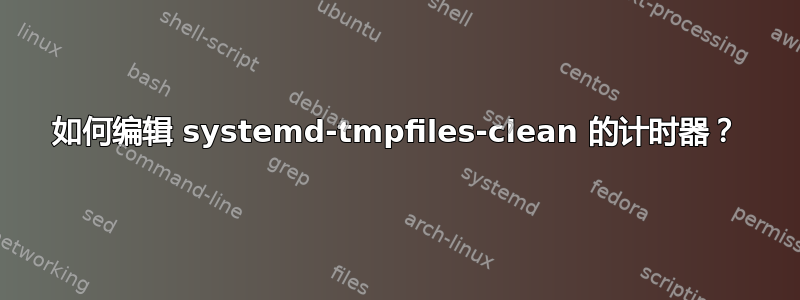
我正在尝试将 Apache PrivateTmp 文件的清理间隔从默认的 30 天更改为 6 小时。我读到要编辑时间间隔,我应该在中设置一个覆盖文件/etc/tmpfiles.d/tmp.conf而不是编辑/usr/lib/tmpfiles.d/tmp.conf,因此我使用以下几行创建了该文件:
# override the default cleanup intervals
v /tmp 1777 root root 6h
v /var/tmp 1777 root root 6h
现在,如果我运行systemd-tmpfiles --clean,预期的文件将被删除,因此这部分正在工作。
然而,/usr/lib/systemd/system/systemd-tmpfiles-clean.timer已OnUnitActiveSec设为1d。我认为这意味着我的 6 小时清理间隔将有效地限制为每天一次。
我可以将该计时器间隔更改为 6 小时或更短,但我应该直接编辑此文件,还是创建一个类似于的覆盖文件/etc/tmpfiles.d?
更新:这个问题被标记为重复,但我在链接的问题中没有看到任何关于我是否应该使用与该tmp.conf文件一样的覆盖文件的内容。
解决方案:显然我无法将其发布为答案,因为该问题已被标记为重复。但这就是我创建覆盖文件来更改计时器间隔的方法:
将现有的定时器文件复制到相应的覆盖目录中:
sudo cp /usr/lib/systemd/system/systemd-tmpfiles-clean.timer /etc/systemd/system
编辑新副本(将 1d 值更改为 1h):
sudo nano /etc/systemd/system/systemd-tmpfiles-clean.timer
加载新的计时器文件:
sudo systemctl daemon-reload
确认新的计时器间隔已加载:
sudo systemctl list-timers
答案1
这个答案有点晚了,但我会把它留在这里,以防其他人偶然发现它。
我认为了解systemd覆盖如何工作的基本机制很重要。您的解决方案表明您了解了低级实现细节以及如何手动创建覆盖,这是一件好事。
为了完整性和传播最佳实践,人们应该使用内置systemctl函数来创建覆盖(正如 @muru 在评论中提到的)。例如:
sudo systemctl edit systemd-tmpfiles-clean.timer
例如,这可以确保在文件上正确设置权限,并减少依赖底层抽象引入错误的可能性。
如果要查看组成该单元的组件,请使用systemctl cat以下命令:
sudo systemctl cat systemd-tmpfiles-clean.timer
# /usr/lib/systemd/system/systemd-tmpfiles-clean.timer
# This file is part of systemd.
#
# systemd is free software; you can redistribute it and/or modify it
# under the terms of the GNU Lesser General Public License as published by
# the Free Software Foundation; either version 2.1 of the License, or
# (at your option) any later version.
[Unit]
Description=Daily Cleanup of Temporary Directories
Documentation=man:tmpfiles.d(5) man:systemd-tmpfiles(8)
[Timer]
OnBootSec=15min
OnUnitActiveSec=1d
# /etc/systemd/system/systemd-tmpfiles-clean.timer.d/override.conf
[Timer]
# reset existing triggers
OnBootSec=
OnUnitActiveSec=
# add new triggers
OnBootSec=15min
OnUnitActiveSec=60min


